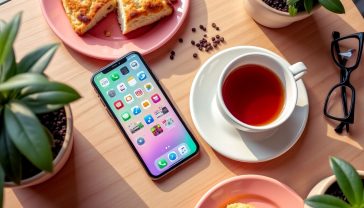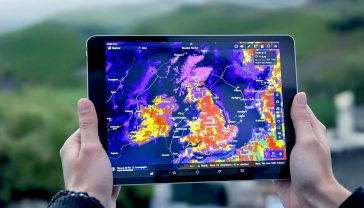10 Best Apps for Offline Music: Enjoy Your Favourite Tunes Anytime, Anywhere
From the Tube to the Highlands, never be without your soundtrack. We break down the best apps like Spotify, Apple Music, and more for offline music in the UK.

This post may contain affiliate links. If you make a purchase through these links, we may earn a commission at no additional cost to you.
Ever been on the Tube, ready to blast your favourite tunes to block out the world, only for the Wi-Fi to cut out? Or maybe you’re heading for a weekend camping trip in the Peak District where phone signal is more myth than reality. We’ve all been there. That dreaded moment when your music stream grinds to a halt, leaving you in silence. It’s a proper pain, isn’t it?
In a world where we’re always connected, it’s easy to forget how much we rely on the internet for our daily dose of music. But whether you’re trying to save on mobile data, travelling abroad, or just venturing somewhere off the beaten path, having your music available offline is a total game-changer. It means your playlists are always there for you, no matter what.
But with so many apps out there, which one is right for you? It’s a crowded field, with big names and hidden gems all promising the best experience. Don’t worry, though – we’ve done the hard work for you. We’ve tested the lot, from the titans of streaming to the specialist players, to bring you the definitive list of the best apps for listening to music offline. Think of this as your ultimate guide to unlocking musical freedom. We’ll break down what each app offers, how much it’ll set you back, and who it’s best for. Let’s dive in and find the perfect app to keep your personal soundtrack playing, no signal required.
Why Bother with Offline Music in 2026?
You might be thinking, “With 5G popping up everywhere, is offline music still a thing?” Absolutely. While our connection speeds are getting faster, there are still plenty of rock-solid reasons why downloading your tunes is a smart move.
First up, saving your precious mobile data. Streaming music, especially high-quality audio, can chew through your data allowance faster than you can say “another one bites the dust.” If you’re on a limited plan, streaming on the go can lead to nasty extra charges or finding yourself cut off before the month is out. By downloading your playlists over Wi-Fi at home, you can listen for hours without using a single megabyte of data.
Then there’s the issue of patchy signal. Let’s be honest, the UK has its fair share of “not-spots.” Whether you’re on a train journey through the Scottish Highlands, navigating the London Underground, or visiting family in a rural village, a reliable internet connection is never guaranteed. Offline music means your journey is filled with killer tracks, not awkward silence.
Travelling abroad is another big one. Using your mobile data overseas can be eye-wateringly expensive, despite some network providers offering roaming packages. Downloading your music before you jet off means you have a ready-made holiday soundtrack without the fear of a massive bill when you get home. Your tunes for the beach, the city break, or the long-haul flight are sorted.
Finally, it’s all about uninterrupted listening and audio quality. When you stream, your music can buffer or drop in quality if your connection weakens. It’s incredibly frustrating when a song stutters right at the best bit. Downloaded files play perfectly every time, with no interruptions. Plus, most premium services let you download tracks in high quality, so you can enjoy your music with crystal-clear sound, just as the artist intended. It’s about taking back control and ensuring your music experience is seamless, reliable, and sounds brilliant.
The Titans of Streaming: The Big Four
When it comes to music streaming, there are a few giants that dominate the scene. These are the household names you’ve almost certainly heard of. They offer massive libraries, slick apps, and, crucially, excellent offline listening features as part of their premium plans.
1. Spotify: The Undisputed King
Spotify is the go-to music app for millions in the UK, and for good reason. It’s incredibly user-friendly, has a colossal library of over 100 million songs, and its music discovery features are second to none.
What’s the Deal with Offline?
With a Spotify Premium subscription, you can download albums, playlists, and podcasts to your device. You can download up to 10,000 songs on each of five different devices, which should be more than enough for even the most dedicated music lover. The process is simple: just find what you want to save and tap the download arrow. A green symbol will appear next to downloaded tracks, so you know they’re ready for offline action.
You can also choose the download quality. Options range from ‘Normal’ to ‘Very High’, which streams at 320 kbit/s. Higher quality means better sound but bigger file sizes, so keep an eye on your phone’s storage. A handy “Offline Mode” in the settings ensures you only play your downloaded content, which is great for saving data without even thinking about it.
How Much Does It Cost?
Spotify’s premium plans are pretty standard for the industry.
- Individual: £10.99 per month.
- Duo: £14.99 per month for two people living at the same address.
- Family: £17.99 per month for up to six family members.
- Student: £5.99 per month, which also includes access to other perks.
There’s no free way to listen offline; this is a strictly premium feature.
Who Is It Best For?
Spotify is perfect for almost everyone. If you love discovering new music through expertly curated playlists like Discover Weekly and Release Radar, and you want an app that just works brilliantly, Spotify Premium is a fantastic choice. It’s the best all-rounder.
2. Apple Music: The Seamless Choice for iPhone Users
If you’re living in the Apple ecosystem, with an iPhone, iPad, or Mac, then Apple Music is a seriously compelling option. It’s beautifully integrated into Apple’s software and boasts a library that rivals Spotify’s, with over 100 million songs.
What’s the Deal with Offline?
As you’d expect, offline playback is a core feature. You can download individual songs, albums, or entire playlists to your library. There’s a dedicated “Downloaded” section in the app, making it easy to find your offline tunes. Apple also offers the ability to automatically download any song you add to your library, which is a neat touch.
One of Apple Music’s biggest selling points is its audio quality. It offers Lossless Audio and Spatial Audio with Dolby Atmos at no extra cost. Downloading in these higher-quality formats will give you a richer, more immersive listening experience, though be warned – the files are much larger. A three-minute song in standard quality is about 6 MB, but in Hi-Res Lossless, it can be over 145 MB!
How Much Does It Cost?
Apple Music’s pricing is very similar to Spotify’s.
- Individual: £10.99 per month.
- Family: £16.99 per month for up to six people.
- Student: £5.99 per month.
- Voice Plan: £4.99 per month (this is a cheaper, Siri-controlled plan that doesn’t include offline downloads).
Who Is It Best For?
Apple Music is a no-brainer for anyone heavily invested in Apple products. The seamless integration, combined with superior audio quality options like Lossless and Spatial Audio, makes it the top choice for audiophiles and Apple fans alike.
3. YouTube Music: More Than Just Music Videos
YouTube Music is Google’s answer to Spotify and Apple Music. Its unique selling point is its deep integration with the vast world of YouTube. This means you get official songs and albums alongside a treasure trove of remixes, live performances, covers, and music videos you won’t find anywhere else.
What’s the Deal with Offline?
With a YouTube Music Premium subscription, you can download songs, albums, and playlists for offline listening. A standout feature is the “Offline Mixtape,” an auto-generated playlist based on your listening habits that the app automatically downloads for you. It’s a great way to have fresh music ready to go without any effort.
You can also choose to download just the audio or the music video, which is a cool feature unique to the platform. Like the others, you can select the download quality to balance sound versus storage space.
How Much Does It Cost?
YouTube Music Premium can be bought on its own or as part of YouTube Premium.
- YouTube Music Premium: £10.99 per month.
- YouTube Premium (includes Music Premium, ad-free YouTube, and background play): £12.99 per month. This is often the better deal.
- Family and Student plans are also available.
Who Is It Best For?
If you’re someone who loves watching live performances and discovering obscure remixes on YouTube, this app is for you. It brilliantly bridges the gap between a traditional music streamer and the endless video content of its parent platform. The full YouTube Premium bundle is also excellent value.
4. Amazon Music Unlimited: The High-Quality Contender
Amazon Music has quietly become a major player in the streaming world, especially for those who are already part of the Amazon ecosystem. It offers a huge library and, like Apple Music, focuses on high-quality audio.
What’s the Deal with Offline?
Amazon Music Unlimited subscribers can download songs, albums, and playlists for offline playback on their mobile devices. The process is straightforward, and the app allows you to manage your downloaded music easily.
The big draw here is the audio quality. Amazon Music Unlimited includes HD (CD-quality) and Ultra HD (better than CD-quality) streaming and downloads at no extra cost. This is a massive perk for anyone with a good pair of headphones who wants to hear every detail in their music. It also supports Spatial Audio on certain tracks.
Prime members get access to a limited version called Amazon Music Prime, which offers a shuffle-based library of 100 million songs and lets you download a selection of “All-Access Playlists” for offline use. It’s a nice bonus but far more restrictive than the full Unlimited service.
How Much Does It Cost?
- Amazon Music Unlimited: £10.99 per month for non-Prime members, or £9.99 per month for Prime members.
- Single-Device Plan: £4.99 per month (for listening on a single Echo or Fire TV device, no offline mobile use).
- Family and Student plans are also on offer.
Who Is It Best For?
Amazon Music Unlimited is a fantastic option for Amazon Prime members due to the slight discount. It’s also a top choice for audiophiles who want high-resolution audio without paying extra for it. If you own an Echo device, its integration is naturally excellent.
Beyond the Giants: Specialist and Niche Apps
While the big four cover most bases, there are other apps that offer something a little different. Whether you’re a DJ, a classical music aficionado, or just want to listen to your own music files, there’s an app for you.
5. Tidal: For the Purist Audiophile
Tidal has built its brand on two things: high-fidelity audio and artist-focused payouts. It’s seen as the premium choice for those who are serious about sound quality.
What’s the Deal with Offline?
Tidal allows you to download tracks, albums, and playlists for offline listening, just like the major players. Where it stands out is the quality of those downloads. With its top-tier subscription, you can download music in HiFi (CD-quality, 1411 kbps) and Master Quality Authenticated (MQA, typically 9216 kbps) formats. This is studio-quality sound in your pocket, though the file sizes are enormous.
Tidal also offers a vast catalogue of high-definition music videos and exclusive content like artist interviews and documentaries, all of which can be downloaded.
How Much Does It Cost?
Tidal has simplified its pricing recently.
- Tidal HiFi: £10.99 per month. This gives you standard quality audio.
- Tidal HiFi Plus: £19.99 per month. This unlocks the top-tier HiFi, MQA, and immersive audio formats like Dolby Atmos.
Who Is It Best For?
Tidal is for the serious audiophile. If you’ve invested in high-end headphones or a dedicated audio system and you can truly hear the difference between a standard MP3 and a lossless file, Tidal HiFi Plus is worth the premium price.
6. Deezer: The Feature-Packed Challenger
Deezer might not have the same brand recognition in the UK as Spotify, but it’s a powerful and feature-rich service that holds its own against the best.
What’s the Deal with Offline?
With a Deezer Premium account, you can download all your favourite content for offline listening. It offers a massive library and good download quality options, including a HiFi tier for CD-quality streaming and downloads.
One of Deezer’s unique features is “Flow,” a personalised, infinite soundtrack that mixes your favourites with new discoveries. It’s like your own personal radio station. Deezer also has a huge collection of podcasts and radio shows. Another cool feature is “SongCatcher,” its built-in song recognition tool, like a Shazam inside your music app.
How Much Does It Cost?
- Deezer Premium: £11.99 per month.
- Family and Student plans are available.
Who Is It Best For?
Deezer is a great alternative for those who want a powerful all-rounder but fancy a change from Spotify. Its Flow feature is excellent for music discovery, and its broad offering of music, podcasts, and radio makes it a strong contender.
7. SoundCloud Go+: For the Love of Remixes and Indie Artists
SoundCloud has long been the home of DJs, producers, and up-and-coming artists. It’s a vibrant community where you can find music that hasn’t hit the mainstream yet.
What’s the Deal with Offline?
The free version of SoundCloud is for streaming only. To save tracks for offline listening, you need a SoundCloud Go+ subscription. This gives you access to SoundCloud’s massive catalogue of over 300 million tracks – from bedroom demos and DJ sets to official releases from major artists. You can save unlimited tracks for offline playback.
How Much Does It Cost?
- SoundCloud Go+: £9.99 per month.
Who Is It Best For?
SoundCloud Go+ is for the musical adventurer. If you love electronic music, DJ mixes, and discovering brand-new artists before they blow up, SoundCloud is your playground. It offers a different kind of library, one that’s raw, diverse, and exciting.
8. Bandcamp: Supporting Artists Directly
Bandcamp isn’t a streaming service in the traditional sense. It’s a digital record store and music community where you directly support the artists you love.
What’s the Deal with Offline?
When you buy music on Bandcamp – whether it’s a single track or a whole album – you can download it as a high-quality file (MP3, FLAC, and more) to keep forever. You own the music. The Bandcamp app allows you to stream your purchases and, crucially, download them for offline playback on your phone.
There’s no subscription. You pay for the music you want, and a significant chunk of that money goes straight to the artist.
How Much Does It Cost?
It’s free to use the app. The cost is whatever you pay for the music you buy. Prices are set by the artists and can range from a few quid for an EP to whatever you feel like paying, as many artists offer a “name your price” option.
Who Is It Best For?
Bandcamp is for the dedicated music fan who wants to directly support independent artists. If you enjoy curating a personal music collection that you actually own, rather than just renting through a subscription, Bandcamp is the most ethical and rewarding platform out there.
Bring Your Own Music: The Best Apps for Your Local Files
What if you already have a massive collection of MP3s on your computer from the good old days of ripping CDs? You don’t need a subscription service to listen to them on your phone. You just need a great music player app.
9. Plexamp: Your Personal Streaming Service
Plex is a media server software that lets you organise your own collection of movies, TV shows, and music and stream it to any device, anywhere. Plexamp is its dedicated, beautifully designed music player app.
What’s the Deal with Offline?
With a Plex Pass (Plex’s premium subscription), you can download music from your personal Plex server directly to your phone using the Plexamp app. It’s like having your own private Spotify. You can download playlists or entire albums for offline listening. It even offers clever features like downloading a few hours of a radio station based on an artist or mood.
The setup is more involved – you need to run the Plex Media Server software on a home computer or network drive – but the result is total control over your music.
How Much Does It Cost?
- Plex Pass: £3.99 per month, £31.99 per year, or a £94.99 lifetime pass.
Who Is It Best For?
Plexamp is for the serious music collector and tinkerer. If you have a huge, well-organised library of digital music files and want a slick, powerful way to access it on the go, Plexamp is in a league of its own.
10. VLC for Mobile: The Do-It-All Media Player
VLC is famous on desktops as the media player that can play absolutely any file format you throw at it. Its mobile app is just as versatile.
What’s the Deal with Offline?
VLC isn’t about streaming; it’s a pure offline player. You can transfer your music files from your computer to your phone via Wi-Fi, cloud services like Dropbox and Google Drive, or a good old-fashioned USB cable. Once the files are on your device, VLC will organise them and play them back flawlessly. It has a simple, no-frills interface and just works.
How Much Does It Cost?
VLC is completely free and open-source. There are no ads and no subscriptions. It’s a project run by volunteers for the love of media.
Who Is It Best For?
VLC is for someone who wants a simple, reliable, and free way to play their own music files without any fuss. If you don’t need the fancy features of a streaming service or Plex, and just want to play the MP3s you already own, VLC is the perfect tool for the job.
How to Download Music for Offline Use: A Quick Guide
Getting your music ready for offline listening is usually pretty simple. Here’s a quick rundown of the process for the main types of apps.
For Subscription Streaming Services (Spotify, Apple Music, etc.):
- Find the Music: Search for the album, playlist, or song you want to save.
- Look for the Download Icon: There will usually be a downward-facing arrow icon. Tap it.
- Wait for the Download to Complete: The app will show you the progress. Once it’s done, you’ll see a confirmation, often a green tick or a phone symbol.
- Check Your Settings: Make sure you’ve selected your desired audio quality and that you’re set to “Download using Wi-Fi only” to avoid using your mobile data.
- Activate Offline Mode: Most apps have a switch in the settings to force them into offline mode, guaranteeing you won’t accidentally stream.
For Apps Playing Your Own Files (VLC, Plexamp):
- Get Your Files Ready: Organise your music files on your computer.
- Transfer Them to Your Phone:
- For VLC: You can use a USB cable, a cloud service like Google Drive, or the app’s built-in Wi-Fi transfer feature.
- For Plexamp: You need the Plex Media Server running on a computer. Add your music library to Plex, then use the Plexamp app to download tracks from your server to your phone.
- Enjoy: Once the files are on your device, the app will automatically find and organise them, ready for you to hit play.
The Future of Music Listening
While offline listening remains essential, the future is likely to be a hybrid one. Services are getting smarter. Imagine an app that knows you’re about to get on the Tube and automatically pre-downloads your daily commute playlist. Or one that intelligently manages your phone’s storage, swapping out older downloaded tracks for fresh ones it thinks you’ll like.
We’re also seeing a continued rise in high-fidelity audio. As more people invest in better headphones and mobile data becomes more plentiful, the demand for crystal-clear, lossless sound will only grow. This will make offline downloading even more important, as these files are much larger.
Ultimately, the goal remains the same: to have the music you love available whenever and wherever you want it. Whether it’s through a slick streaming subscription or your own carefully curated digital collection, the apps on this list put that power right in your hands. So go ahead, download your favourites, and never be caught in silence again.






